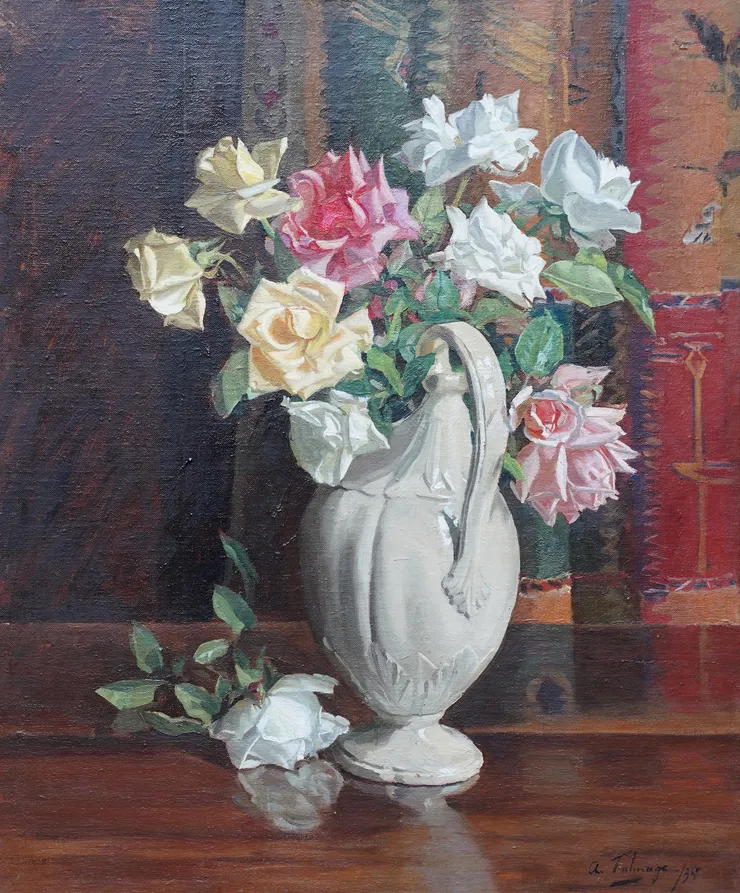Algernon Talmage (1871-1939)
| Artist Name | Algernon Talmage (1871-1939) |
|---|---|
| Title | A Flower Piece - Roses in a White Vase |
| Description | This superb British 1930's exhibited floral oil painting is by noted artist Algernon Talmage. Painted in 1935, the painting was exhibited at the Royal Academy London in 1936 where he was a prolific exhibitor- exhibiting six paintings that year - until his death in 1939. It is a lovely composition of mixed roses in a white porcelain vase on a gleaming wooden table with a patterned curtain behind. The pink, yellow and white roses are in full bloom and one can almost smell their fragrance. Talmage has perfectly depicted all the different textures in the painting and the brushwork and detail are superb. This is a lovely example of Talmage's work with excellent provenance. Signed and dated 1935 lower right. |
| Provenance | Royal Academy 1936, No 86 or No 657, both entitled Flower Piece. W.H Best Ltd Label verso. Signed again and inscribed with the artist's address 49 Elgin Cres W11 verso. |
| Medium | Oil on Canvas |
| Size | 20 x 24 inches |
| Frame | Housed in an ornate gilt frame, inscribed on slip, 31 inches by 27 inches and in good condition. |
| Condition | Good condition. |
| Biography | Algernon Mayow Talmage (23 February 1871– 14 September 1939) RA ROI was a British Impressionist painter. Algernon Talmage was born in Fifield, Oxfordshire, the son of Rev. John Mayow Talmage, a clergyman of Cornish stock. During his childhood, Talmage got into an accident with a gun, permanently injuring his right hand; as a result Talmage painted with his left hand and was exempt from active service in the First World War. In 1892, Talmage studied under Hubert von Herkomer at the Herkomer School of art in Bushey. During his time at Herkomer, Talmage painted alongside Lucy Kemp-Welch, both of whom had a great interest in painting landscapes and horses. From there he moved to St Ives, Cornwall, where he joined the St Ives School. During his time in Cornwall Talmage founded an artists' club which was greatly influenced by the Cornish coastline. Talmage's time in Cornwall was significant in establishing his characteristic mellow palette and enchanting use of light. Talmage is best known for tutoring Emily Carr during her studies at St Ives when he lived and worked in his studio which was then called 'The Cabin' located on Westcotts Quay, St Ives. His criticism was a significant early influence on her work, encouraging her earliest forays into the forest paintings that would eventually become her trademark. Carr's vivid palette grew from his critical reminder that "there is sunlight in the shadows."The well-known Australian painter Will Ashton was another of his students. In 1896, Talmage married Cornish artist Gertrude Rowe and together they had two daughters, Archie and Dorothy. In 1900 Talmage and fellow St Ives School artist Albert Julius Olsson established the Cornish School of Landscape, Figure and Sea Painting. Later, Talmage and Gertrude ran their own art school, with Olsson acting as a 'visiting' artist. Talmage separated from Gertrude in 1907, and moved to Chelsea, London with his former-pupil Hilda Fearon. Throughout his career as an artist, Talmage worked with the mediums of landscape, portrait and animal painting, printing and etching. He held his first solo exhibition in the Goupil Gallery, London, 1909. Talmage is also well known for creating the painting 'The Founding of Australia' which was commissioned by the founder of the Australasian Pioneers Club to celebrate the sesquicentennial of 1938. The finished painting was unveiled at the Royal Academy of the Arts exhibition in London in 1937. The painting depicts the moment Governor Phillip (in the centre of the painting) proposed a toast to King George III, on the evening of 26 January 1788, the day that the Fleet moved from Botany Bay to Sydney Cove. The painting is a celebration of righteousness and importance of colonisation, and a statement of the power of the British Empire. He was elected a member of the Royal Society of British Artists in October 1902. He was a war artist on the Western Front in France.He exhibited many times at the Royal Academy (140), Royal Soc. of British Artists (31) and the Royal Inst. of Oil Painters (30) etc. Talmage was elected to the Royal Academy in 1929. |
| Price | £4000 |

